A Comprehensive Guide on Mole Animal, & Their Life History
Have you ever heard about mole animals? Well, deep beneath the ground, there is a hidden world of animals that many people don’t often know about. These creatures are called mole animals. They are special animals that are good at living underground. They have amazing skills that help them survive in their underground homes.
These creatures have powerful claws and a keen sense of touch and smell. This allows them to navigate and find food in the dark and tight spaces they call their home. It is an amazing world underground for the mole animal that we don’t get to see, but it is incredibly important for our planet and us.
In this blog, we will discuss the mole animals, how they live, and why it is important to protect them and their characteristics.
What are the Mole Animals
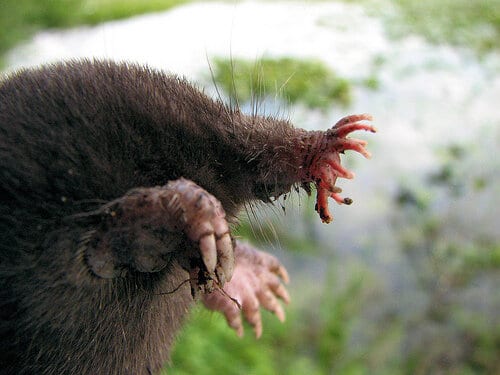
A mole animal is a small creature that lives underground. They are basically like little architects of the underground. They have soft fur and strong paws for digging. These creatures spend most of their time in a hidden world beneath our feet. There are different types of mole animals. Each type has its special features that help it to survive in its own unique underground home. Mole animals are usually not very big, about the size of the hand of a grown-up. They have small eyes and ears because they spend most of the time in dark tunnels they create.
One of the most special abilities that mole animals have is their strong, shovel-like paws that are perfect for digging. They can dig tunnels fast. They are super good at using their sense of touch and smell to find their way around in the dark. This helps them find things to eat, like worms and insects.
Life History of Moles
- Baby Moles, called pups, are born in underground burrows. A mother mole usually has a litter of about 3 to 5 pups.
- When they are born, moles are very small and don’t have fur. They are also blind and can’t see anything.
- Pups stay in the underground burrow for about a month, growing and stronger. During this time, their moms take good care of them.
- As they grow up, the pups learn how to dig tunnels. They watch their mom and try to copy her.
- Young moles start eating solid food when they are a few weeks old. They love to eat insects and worms they find in the soil.
- When they grow a month and a half old, young moles are ready to leave their mom’s burrow and find their territory.
- Moles grow fast. Within a few months, they are almost fully grown.
- After that, the young moles dig their tunnels and make their nests.
- Adult moles play an important role in the environment. They help control insect populations and improve the soil by digging.
- Moles do not live very long in the wild. Usually, they live for a life span of only a few years. But in that time, they do a lot to keep the ecosystem balanced.
Different Habits of Mole Animal
A mole animal is an interesting creature that lives underground. Different habits of moles are
- Digging: Mole animals are good at digging. They use their strong front paws to make tunnels in the ground.
- Eating Insects: Mole animals like to eat insects and small creatures that live in the soil. They have sharp teeth for this.
- Active At Night: Moles are usually active at night. They come out of their tunnels when it is dark.
- Good Swimmers: Even though they spend most of their time underground, moles can swim well when they have to.
- Fast Workers: Mole animals can dig quickly. They can make long tunnels in a short amount of time.
- Sensitive Noses: Moles have a great sense of smell. This helps them to find food in the dark tunnels.
- Hibernation in WInter: In colder climates, mole animals may hibernate during the winter months. They create deeper tunnels below the frost line to stay warm.
Moles come out at night to find their favorite snacks. Moles might be small, but they play a big role in their homes underground.
Conservation of Moles
The conservation of moles is very important for our ecosystem. The conservation status of a mole animal is near threatened. It is very important to take care of them and their homes where they stay. They live underground, and they play an important role in keeping the soil healthy.
Here are some ways we can help conserve a mole animal:
- Protecting Their Habitats: We should ensure that the places where moles live, like fields and gardens, are safe. This means that no one should use any harmful chemicals or dig up their homes.
- Avoiding Harm: When working in gardens or fields, we should be careful not to hurt moles or their tunnels. It is important to be gentle and aware of their homes.
- Balancing the Ecosystem: Moles eat insects and help control their population. This is good for plants and other animal. So, by protecting moles, we’re also helping the environment.
- Being Kind to Moles: If we find a mole that needs help, we should try to contact people who know how to take care of them. They might need special care to get better.
- Learning and Teaching: It’s important to learn about moles and why they’re important. We can share this knowledge with others, like friends and family, so they can also help take care of moles.
To protect moles, it is vital to preserve their natural habitats. Appreciating their role in balancing our ecosystem is crucial. Remember, every small effort counts in ensuring these fascinating creatures continue to stay underground.
Some Different Types of Mole Animals
There are various types of mole animals, each with unique characteristics. These creatures live underground and have special adaptations for their subterranean lifestyle.
Let us explore some of the different types of moles and learn about what makes them special:
1. Eastern Mole
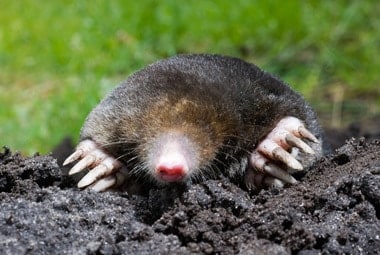
This mole is found in North America, especially in the eastern part of the continent. It has velvety fur that is dark gray to brownish-black. Eastern moles have strong front limbs for digging and a long, hairless tail.
2. Western Mole
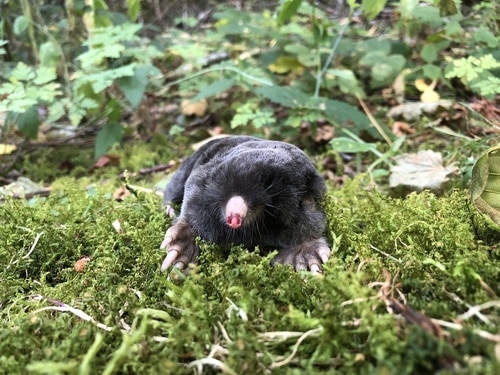
As the name suggests, this mole is found in the western part of North America. It has shorter fur compared to the eastern mole and is usually grayish-brown. Western moles also have powerful digging claws.
3. European Mole
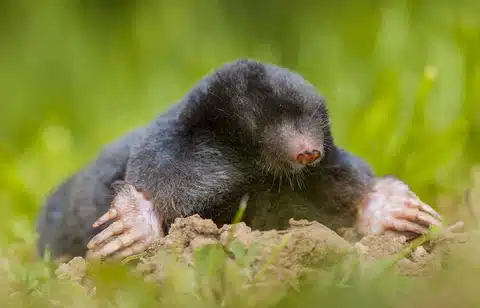
This mole is found in Europe and parts of Asia. It has dark, velvety fur and strong, shovel-like front paws. European moles are known for their distinctive snouts.
4. Star-nosed Mole
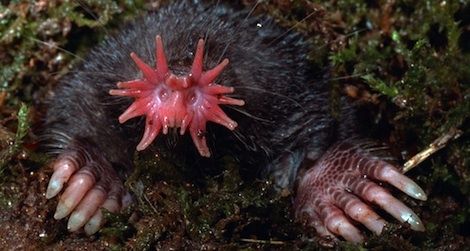
This mole animal is unique. It’s found in North America and is easily recognized by the star-shaped pink appendage on its snout. This appendage has sensitive touch receptors, allowing the mole to find food in the dark.
5. Hairy-Tailed Mole
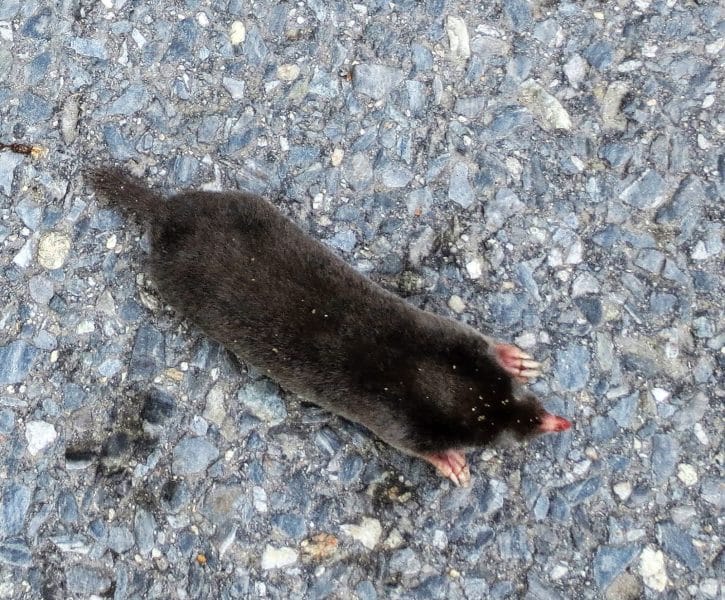
This mole is found in part of North America. It has a long, furry tail, which sets it apart from other mole species. The fur on its body is usually dark brown.
6. Japanese Shrew Mole
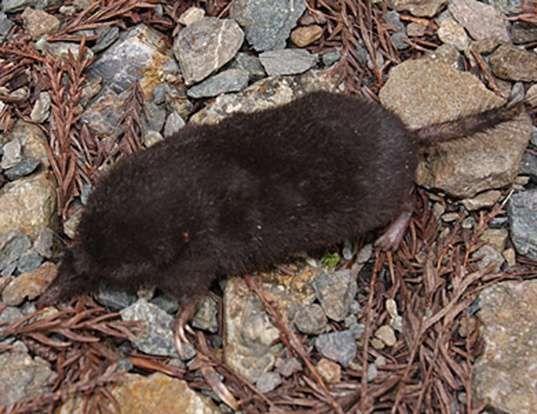
This mole animal is native to Japan. It’s smaller than other species and has a slender, elongated body. It also has a long, pointed snout.
7. Broad-footed Mole
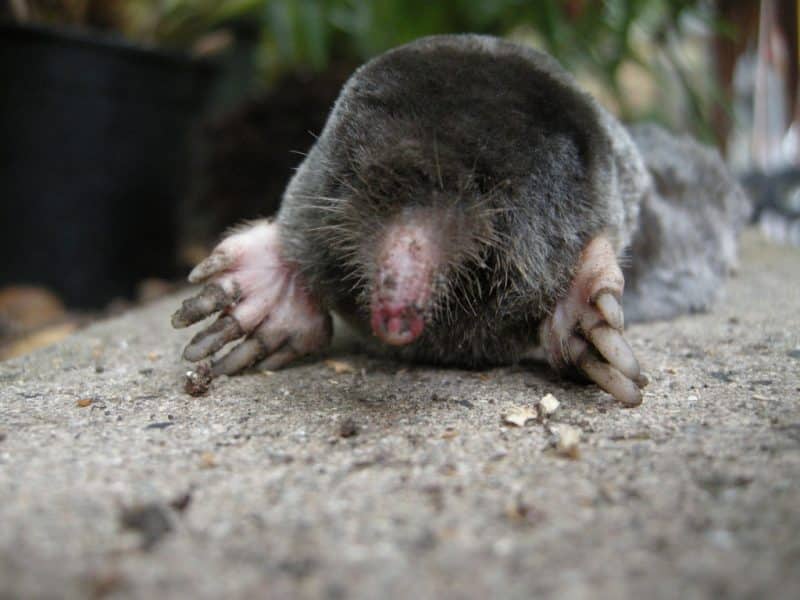
Found in the Western United States, this mole animal has broad front feet and shooter fur compared to other species. It also has a long, pointed snout.
8. Desman
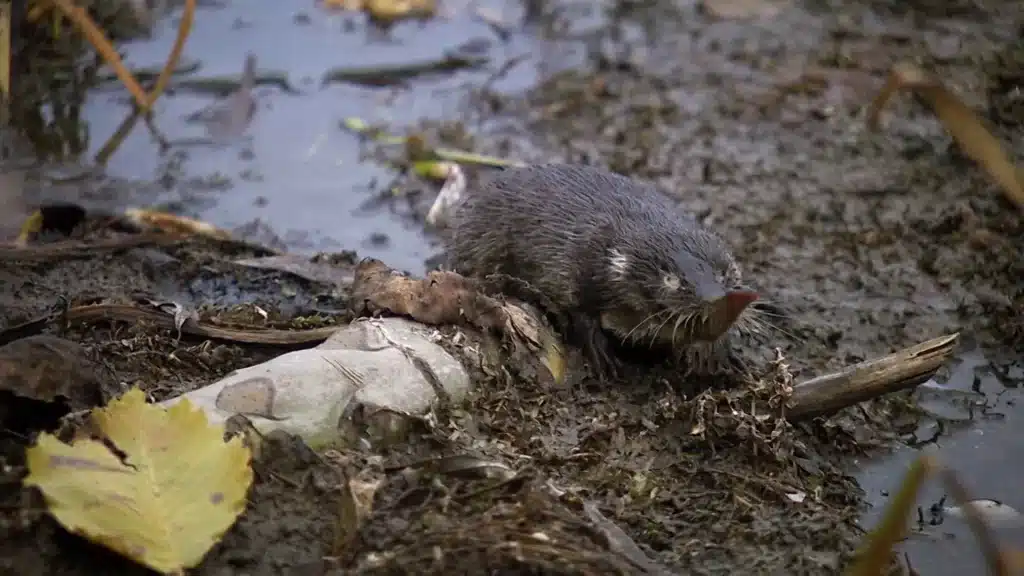
While not technically a mole, the Desman is a mole-like animal in Europe and Asia. It has a long, flexible snout and webbed feet, which make it an excellent swimmer.
9. Golden Mole
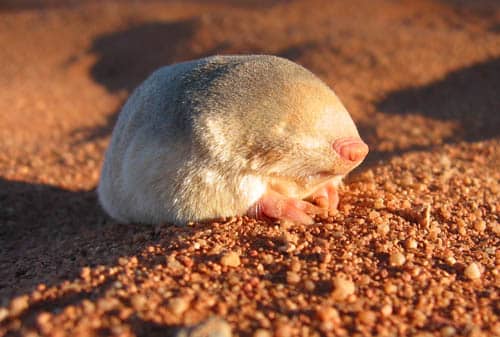
Golden moles are small, shiny creatures that live in Africa. They have soft, silky fur. Golden moles have tiny eyes and sensitive snouts, which help them navigate underground. Even though they are called moles, they are not closely related to the moles we often see in the garden.
Moles are amazing creatures that come in various types. There are common moles in our gardens, and then there are special kinds of moles, like Golden moles, Star-nosed moles, etc. Each type has its special features that help them survive in their different homes.
What Do A Mole Animal Eat
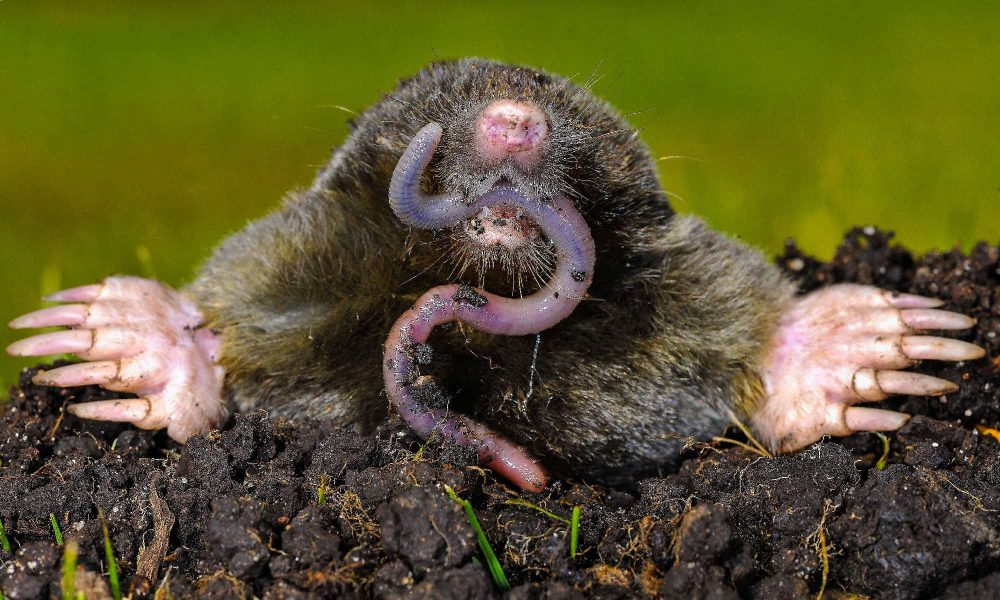
A mole’s diet is quite simple. They eat things they find underground. They mostly eat insects and worms like earthworms, bugs, and other tiny creatures without backbones. It also munches on seeds, underground stems, roots, and special kinds of mushrooms. They have special sharp teeth that help them catch and eat their food. So, moles are like tiny underground hunters.
For those moles that like both land and water, they will even snack on fish and creatures like frogs. These animals have a special juice in their mouths that makes their prey unable to move so it can keep the food for later. This creature can gobble up a meal that weighs the same as its whole body each day. This gives it the power it needs for all the energetic digging it does.
Breeding of A Mole Animal
Moles are small, burrowing creatures that live underground. They have soft fur, small eyes, and strong claws that help them dig tunnels. Moles have a special way of finding their mate. When it is time to find a partner, male moles make tunnels that lead to the surface. They leave little hills of dirt, which we sometimes see in our gardens.
Female mole animals have babies called pups. They usually have a special nesting chamber deep underground where they give birth to their pups. This chamber is cozy and safe for the babies and from any potential danger. Mole pups are born without fur and have their eyes closed. They depend on their mother for milk and warmth. As they grow up, their fur comes in, and they slowly learn how to use their tiny claws to dig.
Mole families stay together until the pups are old enough to go out independently. Then, they start to make their tunnels and find their mates when they grow up.
Scientific Classification of Mole Animal
- Kingdom- Animalia
- Phylum- Chordata
- Class- Mammalia
- Order- Soricomorpha
- Family-Talpidae
- Scientific Name-Talpidae
Taxonomy of Mole Animal
- Moles are part of the animal kingdom.
- They fall under a group called “bilateria,” which means they have bilateral symmetry (like having a left and a right side).
- In a bigger group called “deuterostomes,” which includes animal-like vertebrates (with backbones).
- They belong to the phylum “Chordata,” which includes animals with a nerve cord along their back.
- Within this, they are in a group called “Vertebrata,” meaning they have a spine.
- Even more specifically, they are in a subgroup called “Gnathostomata,” which are animals with jaws.
- They are part of the “Telrapoda” group, which means they’re four-legged vertebrates.
- Moles are mammals, a class of animals that includes creatures like dogs, cats, and humans.
- In the subclass “Theria,” which includes most living mammals.
- Further, they’re in their infraclass “Eutheria,” which are mammals that give birth to well-developed offspring.
- Moles belong to an order called “Soricomorpha,” which includes small insect-eating mammals.
- And finally, they’re in the family “Talpidae,” which is the family that includes all types of moles.
Fun Facts About a Mole Animal
- Moles are like natural bulldozers! They are excellent diggers and can make tunnels through soil quickly. Some moles can dig as fast as a foot (30 centimeters) per minute.
- Moles have a unique foot for digging. Their front paws are like powerful shovels, and they have strong claws that help them break through the soil.
- Most moles are blind, but that doesn’t stop them from getting around. They have a keen sense of touch and can detect vibrations in the ground, which helps them find food and navigate their tunnels.
- Mole are usually loners. They like to have their territory and only come together during the mating season.
- Moles primarily eat insects, worms, and other small invertebrates. They have a huge appetite and can eat their body weight in food every day!
- Because they’re always on the move and have high-energy lifestyles, moles need a lot of food to keep them going.
- You might have seen small mounds of dirt in your yard or garden. These are called molehills, and they’re the result of moles digging their tunnels.
- Even though they’re known for digging, moles are surprisingly good swimmers. They can paddle through water using their front paws.
- There are many different species of moles around the world. Some live in North America, while others can be found in Europe, Asia, and Africa.
- While moles can create tunnels that might disturb gardens, they also help aerate the soil and eat harmful insects, which can be good for the health of a garden.
- Even though they might look a bit like mice, moles are not rodents. They belong to a group of mammals called insectivores.
- Moles have several adaptations that make them perfectly suited for life underground. They have small eyes, powerful forelimbs, and dense fur that help keep dirt out.
Conclusion
Moles are amazing creatures that live underground and have special adaptations that help them thrive in their dark and underground world. Their strong front paws help them dig tunnels and find food like earthworms, bugs, and insects.
Moles also have soft furs that help them move easily through the soil. Also, moles have ears inside their head instead of sticking out. The reason their ears are inside is to stop dirt from getting in. This is also the reason why moles have small eyes. Even though we might not see them much, they keep the earth healthy and our ecosystem safe.
It helps protect the plants by eating the critters that harm their roots and keeps the soil healthy.
Frequently Asked Questions
Where Do Mole Animals Live?
Mole animals inhabit intricate tunnel systems they construct underground. These underground networks serve as their shelter, offering protection from predators and environmental elements. Within these tunnels, boles have specialized chambers for activities like resting, eating, and raising their offspring, popularly known as pups.
Do Mole Animals Hibernate?
Mole animals do not hibernate, but they can exhibit a slowed metabolic rate during winter. They retreat deeper into the soil where temperatures are more stable and that is neither too hot for them nor too cold. This helps to conserve their energy and reduce their activity until conditions improve, that is, the temperature is stable for them.
Are Mole Animals Helpful to The Environment?
Mole animals play a crucial role in ecosystem health. Their tunneling behavior helps aerate the soil, allowing for better water and air circulation, which is beneficial for plant growth. Additionally, moles are natural insect controllers, as they feed on harmful insects and grubs that can damage gardens and lawns.
Can a Mole Animal be Harmful to Humans?
Mole animals are not harmful to humans. While their tunnels can sometimes inconvenience yards, there are humane methods to encourage moles to relocate if their activities become problematic. It’s important to remember that moles go about their natural behaviors in search of food and shelter.
Does a Mole Animal have Good Hearing?
Mole animals have small, hidden ears, and their hearing isn’t their strongest sense. Instead, they rely on touch and smell to navigate their underground world. Their sensitive snouts and whiskers help them sense vibrations and movements in the soil, guiding them through their tunnels. This keen tactile sense allows them to locate prey and avoid obstacles effectively.

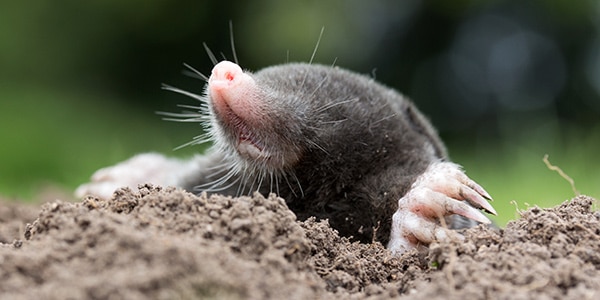
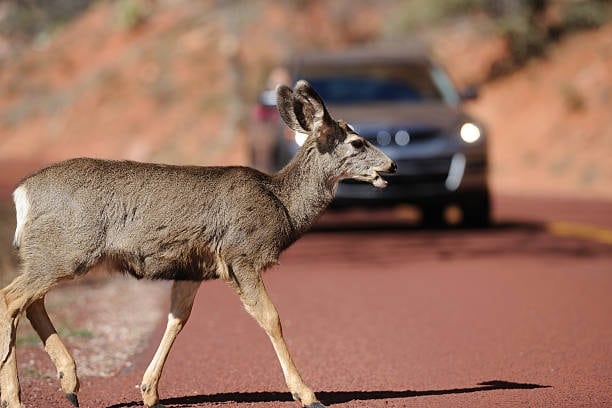
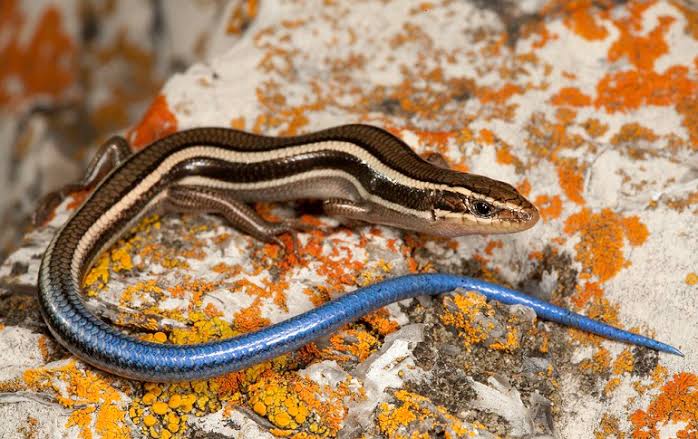
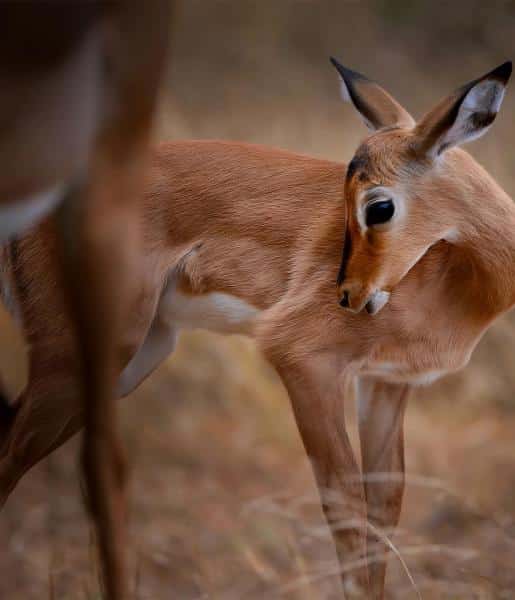
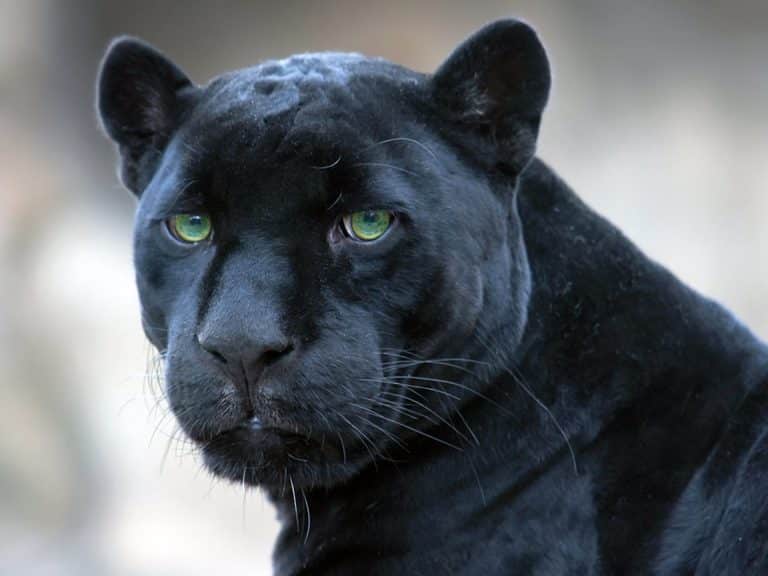
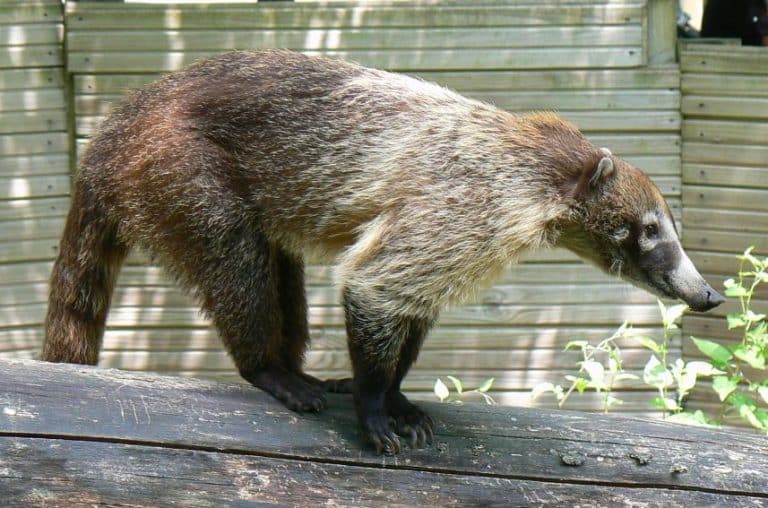

Наличие медицинской страховки перед поездкой за рубеж — это обязательное условие для обеспечения безопасности отдыхающего.
Полис гарантирует медицинскую помощь в случае травмы за границей.
Также, полис может обеспечивать возмещение затрат на репатриацию.
icforce.ru
Определённые государства предусматривают предъявление страховки для въезда.
Без наличия документа лечение могут быть финансово обременительными.
Получение сертификата до поездки